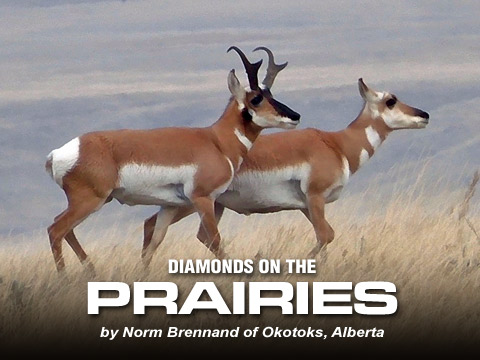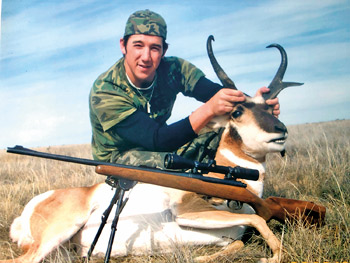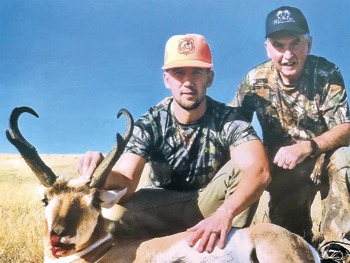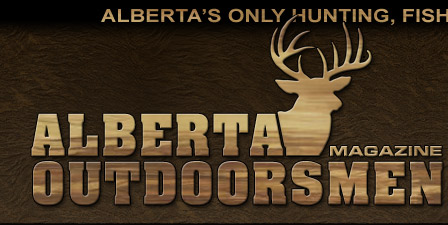|
 |
 |
I have long believed that our antelope, pronghorn, or its common nickname of “Prairie Goat” does not always get the respect it deserves from many Alberta hunters.
I was first attracted to the idea of hunting pronghorn’s way back in the late 60’s when I was working in an Irish pub in Ontario. We had just hired a new bartender from rural Saskatchewan and he was the first person I had ever encountered who had hunted these very unique creatures. Fast forward to the late 80’s and I was lucky enough to take three trips in a row to the Gillette, Wyoming area. Then we moved to God’s Country... Alberta.
 |
| A younger Paul with a fine pronghorn. |
I immediately started building up my priority points and was looking forward to chasing pronghorns, clearly the fastest big game species on the continent boasting, according to the experts, an amazing clip of 92 kilometres per hour. This very distinctive animal has horns, not antlers and is the only species to shed its horns annually. The pronghorn also provides you the excuse to visit territory that you probably wouldn’t normally travel to. As a rule, if the land is desolate, parched, full of cacti and home of the tumbleweed, there’s a good chance you are in pronghorn country. Plus, it’s a damn beautiful animal and every hunter’s man cave only looks better with at least a goat or two displayed in it. However, the #1 reason that I wanted to test my luck on Alberta pronghorns was that it was the perfect hunt to bring my young son Paul along with me on the hunt.
We left Okotoks at 4:00 in the morning not knowing who was more excited, the little kid or the big kid. We just got into goat country, the sun was coming up, all was good, and then my fan belt died on me and Alberta antelope hunt #1 was officially over. It was a good lesson to learn for my young hunter—sometimes life throws us curve balls. By the time we eventually got back home, about 16 hours later, the gun never even got out of its case.
Two or three years flew by and the two of us got out there again but this time, we actually did get out hunting. I had drawn a doe tag. We filled that tag in short order and despite it being a doe, we had as much fun as if we had taken a 17-inch buck.
Then a few years later, finally a crack at a buck. I don’t remember how long one had to wait to get drawn back then as it’s well over 30 years ago, but I do know it wasn’t the 12 or 13 years we require today. We took a small pronghorn, maybe only an 8 or 9 incher but Paul didn’t care, he got to pose in front of the young buck and we were all smiles the rest of the drive home.
Paul got his hunting licence when he was 12 or 13 and for the next 25 plus years, buck or doe tag, it didn’t matter, as a tag of any sort served as our excuse to visit the bald ass prairie. It always seemed to be two main areas where we would hunt, one being south of Highway 570 in the vicinity of Big Stone or the other in the Buffalo area, give or take 100 kilometres.
Paul took his first buck pronghorn when he was about 15 or 16, a small 9 or 10-inch pronghorn that proudly sits on his wall to this day. Then as a young man in his mid-20’s, he got a very respectable 13 1/2-inch buck, it was a true dandy and he was clearly a shooter in every way. I always think that any buck 12 or 13 inches is a fair specimen of the species. Like all big game, the more you hunt them the more particular you tend to become.
If you watch hunting shows as much as I do, the vast majority of pronghorn hunts do not have the hunter shooting something spectacular. Most, surprisingly enough, have little experience with antelope hunting so they tend to shoot the first prairie goat in that 11 to 13-inch range. If you watch closely very few can judge pronghorns with any degree of accuracy. I have a couple of simple rules, the first and the most reliable pertain to the ears. If the buck has horns that are at least twice the length of his ears, then he’s worth the time to get your attention. The second is if the prongs are well turned and growing downwards about an inch, he then gets even more of my time.
I have probably shot 5 or 6 pronghorns with the biggest being just over 15 inches—he’s a fine Alberta goat that you seldom see in Alberta. There’s roughly a healthy population of 20,000 antelope in Alberta. When I was hunting antelope in Wyoming, in the late 80’s, the best estimate was a whopping one-million prairie goats! These days they estimate the population to be “only” 600,000. Back then the key to hunting them was not to fill your tag the first hour, but to be patient and look them over a bit. Without a doubt, the state of New Mexico holds the bragging rights for being home to the biggest pronghorns, as no other state or province holds more entries in the Boone and Crockett as does New Mexico. I once read that you have to see 2000 antelope before you see your first 15 incher—I think there’s some truth to that.
By now my son is in his mid-30’s and he’s now drawn another antelope buck licence. Opening day was Thursday, October 1, 2020. I had found access to much land so we were both excited about his chances. I had driven out six times to scout the area we had selected to hunt, each trip being approximately 900 kilometres. End result, over 5,000 kilometres to get ready for the hunt!
We arrived at our destination just as the sunrise started to appear.
Long time sheep hunting buddy Wayne Starling had driven in from Deslisle and we would be meeting up with him. Once meeting up, the hunt was officially on! We basically had planned on two days of hunting but we were sure hoping to get the deed done the very first day. It had taken Paul 12 years to get drawn so with the tag comes some pressure.
Although I had seen countless pronghorns during my scouting trips, it doesn’t count for anything on opening day. It wasn’t until almost 9:00 am when we finally saw our first buck of any size. I’d guess at 11 to 12 inches but certainly not bigger than that. It would have been a mere 50-yard shot but Paul quickly decided to turn it down. The thinking was that it was still early and my trips to the area indicated a good crop of bucks. But as we all know, there’s no guarantees in hunting.
We covered a lot of country that day and with three sets of binoculars there was no lack of glassing. Nevertheless, it was now closing in on 3:00 pm and we were all getting a tad anxious—we hadn’t seen a single buck since the one Paul passed up, unbelievable!
I was driving on what was more like a cow pasture road when it seemed like all three of us spotted this young buck about 300 yards straight ahead of us. We had dipped down a bit and there he was skylining the hill in front of us. But he had no interest in us; clearly, something else was more important and it was so obvious to tell. We were all looking in the direction of where the buck was staring and it only took a few seconds to see what all the fuss was about... another buck but this one was a dandy! I told Paul to jump out of the truck immediately, as I wanted to drive to the top of the hill where the younger buck was and then just stop there to watch the action unfold. Paul and I had used this tactic before with pronghorns and it usually works like a damn. The bigger buck now had his full attention on us in the truck, while Paul quickly gained valuable ground. He got within 225 yards, lied down on the ground, got his bipods in place, and a few short seconds later it was all over. It was hard to believe what had just happened. Six hours of no antelope whatsoever, and within seconds a pronghorn that most only dream about. Paul made a great shot on a great pronghorn!
 |
| Father and son pronghorn team. |
He turned out to be 14 1/2-inches, which is a super-size but I was impressed with just the overall look of this buck. I would say over 95% of the antelope I see taken on TV do not even come close to looking as good as the one Paul got that day. He’s got the perfect “heart” configuration, ivory, nice bases, and mass... just a super addition to any trophy wall. This buck had it all, truly top of the class. I was ecstatic, out came the cameras and the cell phones. The sky was blue, not a cloud to be seen, low twenties for temperature, and we were all of 300 yards from the truck. When you have a scenario as this, doing the chores is truly a joy.
If you are ever fortunate to take a pronghorn, be sure to take countless pictures and enjoy the moment. The reality is your first pronghorn could very well be your last so cherish the “now”. You young hunters may see the time to draw a tag get closer to 20 years and not the 12 we abide by today. Even the keen goat hunter may one day only have one or two tags to access.
So there you have it my friends, I’m obviously a strong advocate for these prairie critters. But the best thing of all, every time I’ve been fortunate enough to be drawn, or my son, chasing pronghorns makes a great father/son hunt together. The smile on my little hunting buddy over 30 years ago is still the same beaming smile I see on my big hunting buddy today. And the countless memories shared together as we chased these goats is priceless, all thanks to our “diamonds on the prairies”. ■
For previous Reader Stories click here.
|
|
|
|


